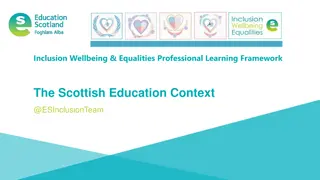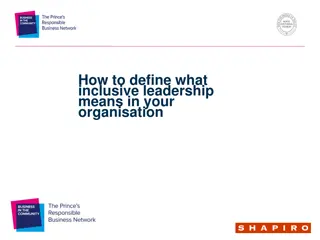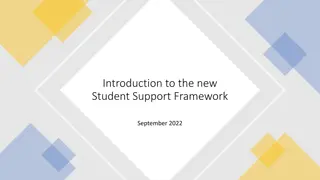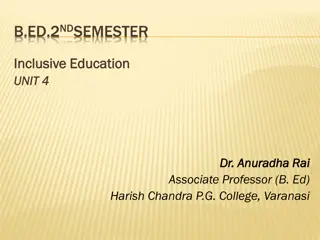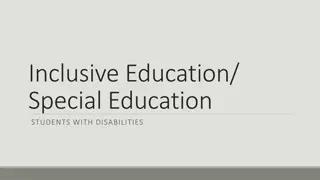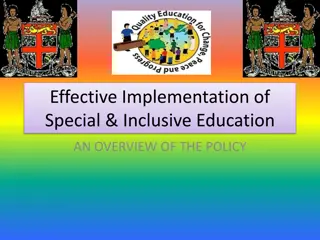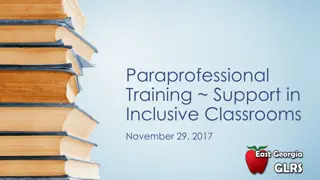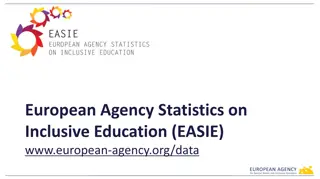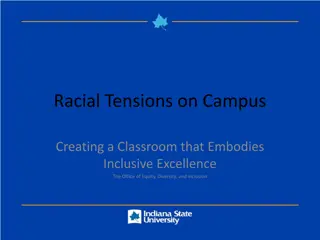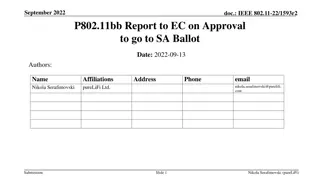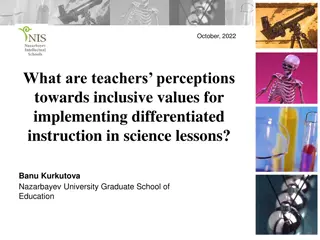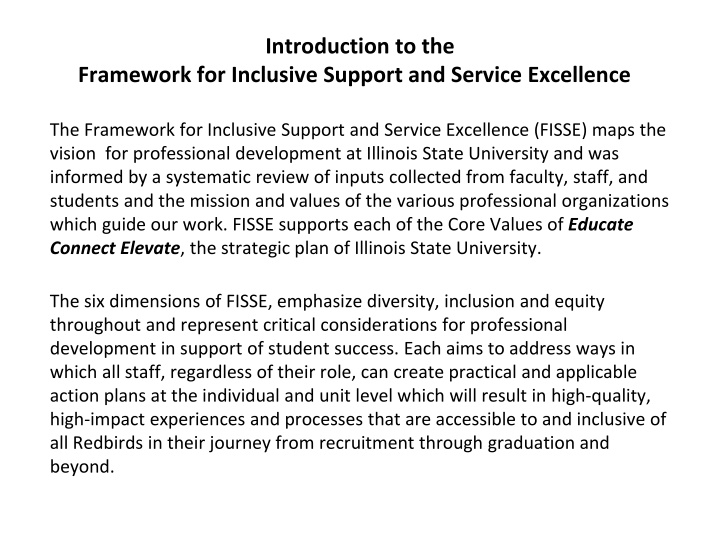
Framework for Cultivating Inclusive Support and Service Excellence
The Framework for Cultivating Inclusive Support and Service Excellence (FISSE) at Illinois State University emphasizes diversity, equity, and inclusion in professional development to enhance student success. It focuses on six key dimensions to guide staff in creating high-quality, accessible, and inclusive experiences for all students from recruitment through graduation and beyond.
Download Presentation

Please find below an Image/Link to download the presentation.
The content on the website is provided AS IS for your information and personal use only. It may not be sold, licensed, or shared on other websites without obtaining consent from the author. If you encounter any issues during the download, it is possible that the publisher has removed the file from their server.
You are allowed to download the files provided on this website for personal or commercial use, subject to the condition that they are used lawfully. All files are the property of their respective owners.
The content on the website is provided AS IS for your information and personal use only. It may not be sold, licensed, or shared on other websites without obtaining consent from the author.
E N D
Presentation Transcript
Introduction to the Framework for Inclusive Support and Service Excellence The Framework for Inclusive Support and Service Excellence (FISSE) maps the vision for professional development at Illinois State University and was informed by a systematic review of inputs collected from faculty, staff, and students and the mission and values of the various professional organizations which guide our work. FISSE supports each of the Core Values of Educate Connect Elevate, the strategic plan of Illinois State University. The six dimensions of FISSE, emphasize diversity, inclusion and equity throughout and represent critical considerations for professional development in support of student success. Each aims to address ways in which all staff, regardless of their role, can create practical and applicable action plans at the individual and unit level which will result in high-quality, high-impact experiences and processes that are accessible to and inclusive of all Redbirds in their journey from recruitment through graduation and beyond.
Framework for Inclusive Support and Service Excellence Thinking bigger than traditional "customer service," striving for excellence in the delivery of high impact practices to assist and engage students and their families throughout their journey from recruitment through graduation and beyond. A variety of assessments should be employed to understand students' individual and collective feedback and needs. A range of assessments offer the opportunity to hear the voice of the student and allow adjustments to be made to policies and procedures, outreach strategies, and services offered. Critical reflection requires the use of a variety of data to consider practices, biases, and awareness of students' needs. Ultimately, data-based reflection should inform continuous improvements to service. Feedback, Assessment, and Data Informed Reflection Service and Support Impact of Outreach and Programming Collaboration and Teamwork Accessible and equity minded practices are vital in the development and implementation of programs and services. Purposeful and strategic support of learning and growth are provided in and outside the classroom. Service should align with University values, vision, and goals. Creation of strong inclusive teams and campus partnerships will boost productivity, creativity, and support students' best interests and success. Leadership and Mentoring Climate and Culture As leaders and role models for students, intentional and inclusive practices are key to mentoring, advising, coaching, and serving students. Personal and professional growth is encouraged as knowledge and skills related to student development and success will support mission and goals. Campus climate is reflected in the physical, social, and emotional spaces where students learn and grow. Appreciation and understanding of differences allow staff to foster a positive climate through the intentional development of a supportive culture for all students through the application of practices that support and encourage student engagement, development, and success.
Service and Support Clear communication: content, policies, and procedures are communicated consistently and with fidelity transparentexpectations appropriate rate/pacing of communication and content responsive communication (time and tone) multiple delivery methods Service with intentionality: live the value of providing individualized attention high impact practices problem solving appropriate and timely referrals empathy, care, and compassion recognize diversity of students and diversity of student needs enthusiasm towards students and service inputfrom students is valued expectations of student success Communicate with clarity Service with intentionality Effective, inclusive service Choose roles to support student success: resource advisor mentor coach facilitator of student empowerment educator motivator advocate Identify variables that influence service and support : prior knowledge and experiences individual and social construction of knowledge observational and experiential learning exclusion based on identity or group membership social, emotional, financial, and outside influences Motivation and student success Foster motivation and engagement: empower students to engage and make connections between in and out of classroom experiences studentinvolvement studentmotivation impact of student cultural wealth in and out of the classroom build confidence via GROWTH mindset studentengagement techniques engage parents/families as advocates in student success and independence The dimension of Service and Support can be described as follows: Thinking bigger than traditional "customer service," striving for excellence in the delivery of high impact practices to assist and engage students and their families throughout their journey from recruitment through graduation and beyond.
Impact of Outreach and Programming Ensure representation across all populations of students (gender, race, ability, language status, sexual identity, etc.): multiple voices/perspectives evident reflect diverse identities and experiences reflection on positionally/power dynamics students as co-creators of content student see themselves reflected Inclusivity Design Frame service with student success in mind: accessibility equity-minded design for outcomes identification of essential and relevant content inclusion of multiple perspectives in content and design supports mission and values student access to technologies and connectivity Effective, inclusive service Identify potential barriers to inclusion: content based on specific cultural frames content favors or excludes certain perspectives relegation of historically marginalized voices into brief segments rather than throughout tokenization Identify variables that impact outreach and programming: feelings of inclusion/exclusion perceived relevance of content to students lives delivery methods timing technology tools and connectivity Delivery Delivery approach to facilitate student success: creativity in delivery multiple delivery methods universal design organized clear and continuous communication detailed record keeping prompt feedback and response technology considerations instructions and training The dimension of Impact of Outreach and Programming can be described as follows: Accessible and equity minded practices are vital in the development and implementation of programs and services. Purposeful and strategic support of learning and growth are provided in and outside the classroom.
Leadership and Mentoring Taking responsibility for personal growth: professional development involvement in professional organizations growing outside of comfort zone encourage growth mindset initiative for proactive learning role as life-long learner Leading with intentionality: role modeling campus involvement building relationships civic engagement empathy, care, and compassion recognizing diversity of students and diversity of student needs input/feedback from students is requested and valued expectation of student success hiring practices that are equity minded Inspire personal and professional growth Intentional leadership Effective, inclusive service Reflection on own behaviors: student s perception/feedback colleague perceptions/feedback ownership of biases and identities positionality and privilege own vs other s experiences with the world (e.g. people with disabilities, LGBTQ+, people from different racial/ethnic/linguistic backgrounds) Choose roles to support leadership and mentoring: resource advisor mentor coach facilitator of student empowerment educator motivator advocate Promote student development Apply strategies to promote development and student success: focus on student holistically socially, academically, emotionally, professionally, financially, etc. individualized attention build confidence via growth mindset studentengagement techniques teachable moments facilitate and encourage involvement/engagement, critical thinking/problem solving, and move toward independence promote self-reflection empowerment The dimension of Leadership and Mentoring can be described as follows: As leaders and role models for students, intentional and inclusive practices are key to mentoring, advising, coaching, and serving students. Personal and professional growth is encouraged as knowledge and skills related to student development and success will support mission and goals.
Climate and Culture Interactions, discussions, awareness of students experiences sociopolitical consciousness Practice behaviors that improve climate: inward and outward reflection implicit bias training avoidance of inflammatory language awareness of privilege and power distribution ensure that practices and processes are inclusive and equitable examine ways to break down barriers to student success foster welcoming, safe, and approachable spaces encourage creative solution focus hiring practices that are equity minded Demonstrate awareness as staff member: effort to understand student identities and experiences effort to understand student financial considerations avoidance of making judgments about students understand world events and how they might impact students empathy training Campus climate Effective, inclusive service Honor student needs: trauma-informed strategies and practices ways to build trust facilitation of difficult dialogues knowledge of resources for students on campus Climate impact on student learning and engagement Choose roles to support leadership and mentoring: resource advisor mentor coach facilitator of student empowerment educator motivator advocate Recognize factors that impact campus climate: quality of staff-student and student-student interactions recognizing and supporting individual cultural wealth encouraging vs. punitive tone for communication impact of tone on student willingness to seek help/support stereotype/stereotype threat microaggressions sense of belonging students intellectual and social-developmental level students prior experiences ability to learn from mistakes The dimension of Climate and Culture can be described as follows: Campus climate is reflected in the physical, social, and emotional spaces where students learn and grow. Appreciation and understanding of differences allow staff to foster a positive climate through the intentional development of a supportive culture for all students through the application of practices that support and encourage student engagement, development, and success.
Collaboration and Teamwork Leverage campus partnerships: creative planning across divisions and departments effective communication and transparency build on existing partnerships solution focused Commitment to shared values/ vision/goals: work to support shared values and vision align and focus goals and objectives with student success in mind work should be approached with an asset-mindset not a deficit-mindset best interest of the student at heart ensure consistent communication of values, vision, and goals embrace cultural wealth Campus partnerships Shared values, vision and goals Effective, inclusive service Inclusive team environment Choose roles to collaboration and teamwork: resource advisor mentor coach facilitator of student empowerment educator motivator advocate Create inclusive team environment: relationshipbuilding effective communication and transparency environmentfor all voices to be heard and valued involve students as partners respect different work styles acknowledge and utilize strengths instill sense of belonging and ownership empowerment work with integrity hiring practices that are equity minded The dimension of Collaboration and Teamwork can be described as follows: Service should align with University values, vision, and goals. Creation of strong inclusive teams and campus partnerships will boost productivity, creativity, and support students' best interests and success.
Feedback, Assessment, and Data-Informed Reflection Understand equity as critical to student success: diversity consciousness participation/success of all students with attentionto the success of students from historically underrepresented racial/ ethnic groups remediation of institutional/staffactions rather than students actions alone disaggregated data and qualitative findings as feedback loops goal setting and planning for equity-minded service, policies and procedures recognition of personal role in student retention and success Strategies for inclusive feedback: studentself-evaluation technology for efficient feedback support for students to make connections between feedback and improvement feedback to check for understanding Equity- mindedness Inclusive feedback Effective, inclusive service Ensure service practices and policies bolster student success: critically and regularly review policies and procedures expectations for success are clearly articulated fair, consistent, and transparent policies and practices technology considerations Using data to inform reflection The dimension of Feedback, Assessment and Data-Informed Reflectioncan be described as follows: A variety of assessments should be employed to understand students' individual and collective feedback and needs. A range of assessments offer the opportunity to hear the voice of the student and allow adjustments to be made to policies and procedures, outreach strategies, and services offered. Critical reflection requires the use of a variety of data to consider practices, biases, and awareness of students' needs. Ultimately, data-based reflection should inform continuous improvements to service. Seek data to inform equity-minded practices and procedures: student perceptions/experiences (e.g., student satisfaction survey, midterm chats, check-ins) frequent monitoring to make adjustments disaggregated data as a class and across identity groups Reflection on own behaviors: student s perception/feedback colleague perceptions/feedback ownership of biases and identities positionally and privilege own vs other s experiences with the world (e.g. people with disabilities, LGBTQ+, people from different racial/ethnic/linguistic backgrounds)





